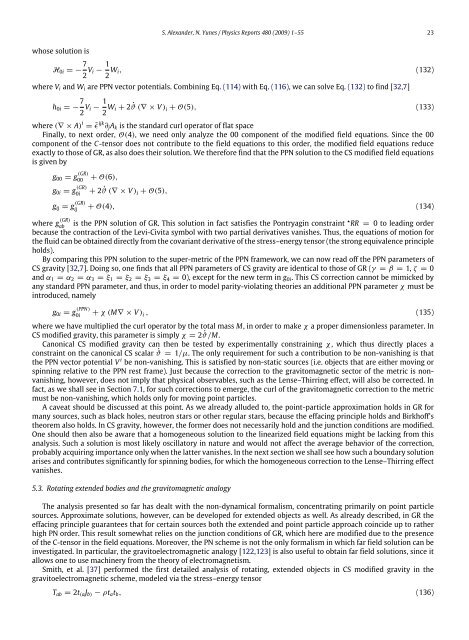Physics Reports ChernâSimons modified general relativity
Physics Reports ChernâSimons modified general relativity
Physics Reports ChernâSimons modified general relativity
Create successful ePaper yourself
Turn your PDF publications into a flip-book with our unique Google optimized e-Paper software.
S. Alexander, N. Yunes / <strong>Physics</strong> <strong>Reports</strong> 480 (2009) 1–55 23whose solution isH 0i = − 7 2 V i − 1 2 W i, (132)where V i and W i are PPN vector potentials. Combining Eq. (114) with Eq. (116), we can solve Eq. (132) to find [32,7]h 0i = − 7 2 V i − 1 2 W i + 2 ˙ϑ (∇ × V) i + O(5), (133)where (∇ × A) i = ˜ɛ ijk ∂ j A k is the standard curl operator of flat spaceFinally, to next order, O(4), we need only analyze the 00 component of the <strong>modified</strong> field equations. Since the 00component of the C-tensor does not contribute to the field equations to this order, the <strong>modified</strong> field equations reduceexactly to those of GR, as also does their solution. We therefore find that the PPN solution to the CS <strong>modified</strong> field equationsis given byg 00 = g (GR)00+ O(6),g 0i = g (GR)0i+ 2 ˙ϑ (∇ × V) i + O(5),g ij = g (GR)ij+ O(4), (134)where g (GR)abis the PPN solution of GR. This solution in fact satisfies the Pontryagin constraint ⋆ RR = 0 to leading orderbecause the contraction of the Levi-Civita symbol with two partial derivatives vanishes. Thus, the equations of motion forthe fluid can be obtained directly from the covariant derivative of the stress–energy tensor (the strong equivalence principleholds).By comparing this PPN solution to the super-metric of the PPN framework, we can now read off the PPN parameters ofCS gravity [32,7]. Doing so, one finds that all PPN parameters of CS gravity are identical to those of GR (γ = β = 1, ζ = 0and α 1 = α 2 = α 3 = ξ 1 = ξ 2 = ξ 3 = ξ 4 = 0), except for the new term in g 0i . This CS correction cannot be mimicked byany standard PPN parameter, and thus, in order to model parity-violating theories an additional PPN parameter χ must beintroduced, namelyg 0i = g (PPN)0i+ χ (M∇ × V) i , (135)where we have multiplied the curl operator by the total mass M, in order to make χ a proper dimensionless parameter. InCS <strong>modified</strong> gravity, this parameter is simply χ = 2 ˙ϑ/M.Canonical CS <strong>modified</strong> gravity can then be tested by experimentally constraining χ, which thus directly places aconstraint on the canonical CS scalar ˙ϑ = 1/µ. The only requirement for such a contribution to be non-vanishing is thatthe PPN vector potential V i be non-vanishing. This is satisfied by non-static sources (i.e. objects that are either moving orspinning relative to the PPN rest frame). Just because the correction to the gravitomagnetic sector of the metric is nonvanishing,however, does not imply that physical observables, such as the Lense–Thirring effect, will also be corrected. Infact, as we shall see in Section 7.1, for such corrections to emerge, the curl of the gravitomagnetic correction to the metricmust be non-vanishing, which holds only for moving point particles.A caveat should be discussed at this point. As we already alluded to, the point-particle approximation holds in GR formany sources, such as black holes, neutron stars or other regular stars, because the effacing principle holds and Birkhoff’stheorem also holds. In CS gravity, however, the former does not necessarily hold and the junction conditions are <strong>modified</strong>.One should then also be aware that a homogeneous solution to the linearized field equations might be lacking from thisanalysis. Such a solution is most likely oscillatory in nature and would not affect the average behavior of the correction,probably acquiring importance only when the latter vanishes. In the next section we shall see how such a boundary solutionarises and contributes significantly for spinning bodies, for which the homogeneous correction to the Lense–Thirring effectvanishes.5.3. Rotating extended bodies and the gravitomagnetic analogyThe analysis presented so far has dealt with the non-dynamical formalism, concentrating primarily on point particlesources. Approximate solutions, however, can be developed for extended objects as well. As already described, in GR theeffacing principle guarantees that for certain sources both the extended and point particle approach coincide up to ratherhigh PN order. This result somewhat relies on the junction conditions of GR, which here are <strong>modified</strong> due to the presenceof the C-tensor in the field equations. Moreover, the PN scheme is not the only formalism in which far field solution can beinvestigated. In particular, the gravitoelectromagnetic analogy [122,123] is also useful to obtain far field solutions, since itallows one to use machinery from the theory of electromagnetism.Smith, et al. [37] performed the first detailed analysis of rotating, extended objects in CS <strong>modified</strong> gravity in thegravitoelectromagnetic scheme, modeled via the stress–energy tensorT ab = 2t (a J b) − ρt a t b , (136)



![arXiv:1001.0993v1 [hep-ph] 6 Jan 2010](https://img.yumpu.com/51282177/1/190x245/arxiv10010993v1-hep-ph-6-jan-2010.jpg?quality=85)


![arXiv:1008.3907v2 [astro-ph.CO] 1 Nov 2011](https://img.yumpu.com/48909562/1/190x245/arxiv10083907v2-astro-phco-1-nov-2011.jpg?quality=85)







![arXiv:1002.4928v1 [gr-qc] 26 Feb 2010](https://img.yumpu.com/41209516/1/190x245/arxiv10024928v1-gr-qc-26-feb-2010.jpg?quality=85)
![arXiv:1206.2653v1 [astro-ph.CO] 12 Jun 2012](https://img.yumpu.com/39510078/1/190x245/arxiv12062653v1-astro-phco-12-jun-2012.jpg?quality=85)
